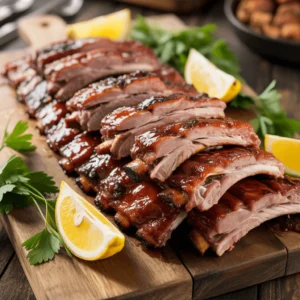Spaghetti alla puttanesca is more than just a meal; it’s a story in a bowl. This iconic Italian pasta recipe delivers an unforgettable flavor explosion with its powerful medley of salty anchovies, briny capers, pungent garlic, and juicy olives, all simmered in a rich tomato sauce. It’s the definition of quick, easy, and sophisticated comfort food that comes together in less than 30 minutes. Dive into the history, master the method, and discover why this dish has captivated palates worldwide.
The History and Folklore of Pasta Puttanesca
The name “alla puttanesca” is as intriguing as the dish itself, translating roughly to “in the style of a prostitute.” The origins of this spicy pasta are shrouded in colorful legend, offering a few compelling tales:
- The “Ladies of the Night” Theory: The most common folklore suggests that the potent aroma of the sauce—garlic, anchovies, and olives cooking—was used by women in Naples to attract customers from the streets. The dish was also famously quick to prepare between appointments.
- The Pantry Theory: A more pragmatic story credits a group of hungry friends on the island of Ischia. When asked to make a meal late at night, the host supposedly declared, “Facci una puttanata qualsiasi!” (“Just make any old garbage!”). He used “puttanata” (meaning something worthless or thrown together) to describe whipping up a sauce from pantry staples like tomatoes, olives, and capers.
- The Modern Invention Theory: Some food historians point to the recipe first appearing in a 1961 Italian cookbook by Eduardo Filippini, solidifying its place in the canon of classic Italian cuisine.
Regardless of its true origin, the name stuck, evoking a sense of bold, rustic, and irresistibly seductive cooking.
5 Reasons to Fall in Love with This Italian Pasta Recipe
Why has this dish become a global phenomenon? The reasons are as clear as a fine extra virgin olive oil.
- A Symphony of Bold Flavors: This is not a shy pasta. It’s a masterclass in umami-rich ingredients working in harmony. The saltiness, the acidity, the savoriness—it’s a complex taste profile that excites the palate.
- Unbeatable Speed and Ease: Truly a 30-minute meal, this quick pasta dish is the perfect solution for busy weeknights or impromptu dinners when you need something impressive fast.
- Pantry Powerhouse: The beauty lies in its use of non-perishable staples. With a well-stocked cupboard, you can create a gourmet-level meal without a trip to the grocery store.
- Incredibly Versatile: While perfect with spaghetti, the sauce is a dream paired with bucatini, linguine, or even a sturdy rigatoni. It’s also easily adaptable for vegetarians.
- A Taste of Authenticity: Making puttanesca is like taking a quick trip to a Southern Italian coastal village. It’s humble, honest, and deeply satisfying food.
Gathering Your Puttanesca Ingredients: A Guide to Quality
The simplicity of this dish means every ingredient counts. Using high-quality components will elevate your sauce from good to extraordinary.
Core Components (The Non-Negotiables):

- Pasta: 1 lb (450 g) of spaghetti or bucatini.
- Tomatoes: 1 (28-oz / 800-g) can of whole peeled San Marzano tomatoes, crushed by hand. Their low acidity and sweet flavor are ideal.
- Olives: ½ cup of pitted black olives (Gaeta or Kalamata) and/or green olives, roughly chopped.
- Capers: 3 tablespoons of salt-packed capers, rinsed thoroughly and drained. If using brined capers, rinse well.
- Anchovies: 6-8 oil-packed anchovy fillets, finely minced. They will melt into the sauce, providing depth, not a fishy taste.
- Garlic: 4-5 large cloves, thinly sliced or minced.
- Chili Flakes: ½ – 1 teaspoon of red pepper flakes (peperoncino), to your preferred heat level.
- Herbs: ¼ cup fresh flat-leaf parsley, chopped, plus more for garnish.
- Oil: 3 tablespoons extra virgin olive oil.
The Flavor Enhancers (Highly Recommended):
- Oregano: 1 teaspoon dried oregano.
- Basil: A few fresh basil leaves for garnish.
- High-Quality Finish: A drizzle of your best extra virgin olive oil to finish.
Crafting the Perfect Spaghetti Puttanesca: A Step-by-Step Guide
Follow these instructions for a flawless, restaurant-quality result every time.
1: Prepare Your Ingredients (5 Minutes)
This sauce comes together quickly, so have everything prepped and within reach. Rinse the capers, chop the olives, mince the anchovies and garlic, and chop the parsley. Crush the canned tomatoes by hand in a bowl for a rustic texture.
2: Build the Flavor Foundation (2 Minutes)
Bring a large pot of well-salted water to a boil for the pasta. In a large skillet or sauté pan, heat the extra virgin olive oil over medium heat. Add the minced anchovies and cook for 1-2 minutes, mashing them with a spoon until they literally “melt” into the oil. This creates an incredible umami base.
3: Sauté the Aromatics (1-2 Minutes)
Add the sliced garlic and red pepper flakes to the pan. Sauté for just 60-90 seconds until the garlic is fragrant but not browned. Burnt garlic will make the sauce bitter.
4: Create the Sauce (12-15 Minutes)
Add the crushed tomatoes, chopped olives, and rinsed capers to the pan. Stir in the dried oregano. Bring the sauce to a simmer, then reduce the heat to low. Let it cook, uncovered, for 10-15 minutes, allowing the flavors to meld and the sauce to thicken slightly.
5: Cook the Pasta (8-10 Minutes)
While the sauce simmers, add the spaghetti to the boiling water and cook until it is al dente (usually 1 minute less than the package instructions). Reserve 1 cup of the starchy pasta water before draining.
6: The Magic Union (2-3 Minutes)
Add the drained al dente pasta directly to the skillet with the sauce. Pour in about ½ cup of the reserved pasta water. Using tongs, toss the pasta vigorously for 1-2 minutes over low heat. The starch in the water will help the sauce emulsify and cling to every strand of pasta. If the sauce seems too thick, add more pasta water a splash at a time.
7: The Final Touch (1 Minute)
Remove the skillet from the heat. Stir in the majority of the chopped parsley, saving some for garnish. Give it one final toss.
8: Plate and Serve (2 Minutes)
Divide the pasta among warmed bowls. Garnish with the remaining fresh parsley, a final drizzle of high-quality extra virgin olive oil, and a few fresh basil leaves. Serve immediately with a sprinkle of extra red pepper flakes for those who want more heat.
Pro Chef Tips for the Ultimate Puttanesca Experience
- Salt Wisely: The olives, capers, and anchovies are very salty. Do not add salt to the sauce until you’ve tasted it at the end. You likely won’t need any.
- Embrace the Emulsion: The step of tossing the pasta in the sauce with the starchy water (mantecatura) is non-negotiable. It transforms the dish from “pasta with sauce” to a cohesive, creamy (without cream!) masterpiece.
- Texture is Key: Use salt-packed capers if you can find them; they have a firmer texture and brighter flavor than brined ones. Roughly chopping the olives ensures a bit in every bite.
- Vegetarian Twist: For a vegetarian puttanesca, simply omit the anchovies. The olives and capers provide plenty of salty, savory depth.
- Wine Pairing: The bold flavors of this pasta pair beautifully with a high-acid, medium-bodied red wine like Chianti or Montepulciano d’Abruzzo. A crisp white like Verdicchio or Pinot Grigio also works wonderfully.
Frequently Asked Questions (FAQ)
1. What does “puttanesca” mean?
It translates to “in the style of a prostitute.” The name’s origins are debated, ranging from folklore about its use by “ladies of the night” to a phrase meaning “thrown together.”
2. Can I make puttanesca sauce without anchovies?
Absolutely. While anchovies provide a deep umami backbone, the sauce will still be delicious without them, making it an excellent vegetarian pasta option.
3. What kind of olives are best for puttanesca?
Traditional recipes use Gaeta olives, but Kalamata olives are a great and widely available substitute. A mix of black and green olives adds complexity.
4. Is puttanesca sauce very spicy?
The heat level is completely customizable. Start with ½ teaspoon of red pepper flakes and add more if you desire a spicier kick.
5. How should I store leftovers?
Store leftover pasta and sauce in an airtight container in the refrigerator for up to 3 days. Reheat gently in a skillet with a splash of water to loosen the sauce.
6. Can I freeze puttanesca sauce?
Yes, the sauce freezes beautifully for up to 3 months. Freeze it without the pasta. Thaw overnight in the fridge and reheat in a pan, cooking fresh pasta to go with it.
7. What pasta shape is best?
Spaghetti is the classic choice, but linguine, bucatini, and vermicelli are also excellent. The long shapes are perfect for holding the chunky sauce.
8. Why are my capers so salty?
Always rinse capers thoroughly under cold water before using them to remove excess salt or brine. This prevents the dish from becoming overly salty.
9. What can I use if I don’t have canned tomatoes?
In a pinch, you can use 2 cups of a good-quality, plain jarred marinara sauce as a base.
10. What protein can I add?
While not traditional, cooked shrimp or flaked canned tuna can be added for extra protein and make for a hearty seafood pasta.
🌟 Your Perfect Puttanesca Awaits!
There you have it—the secrets to a truly unforgettable Spaghetti alla Puttanesca. From its cheeky folklore to its bold, briny flavor profile, this dish is sure to become a weeknight hero in your kitchen.
Tried this recipe? Leave a comment below and rate it! 🌶️ We love hearing about your culinary creations. Don’t forget to tag us on Instagram @tastydinnerrecipes #PuttanescaPerfection for a chance to be featured!
Hungry for more? Explore our other authentic pasta recipes:



